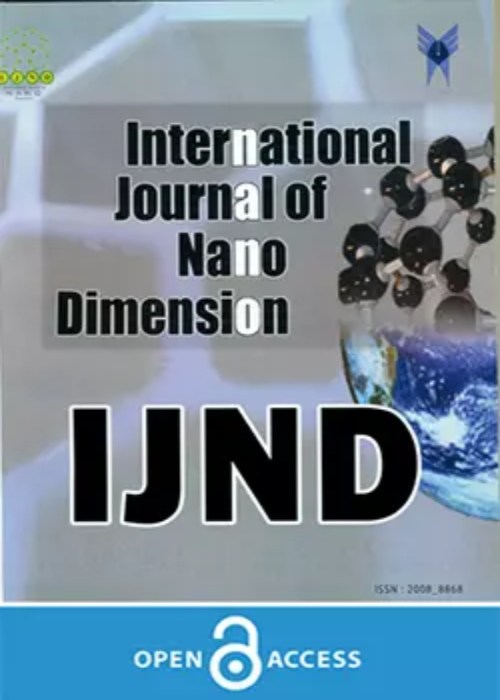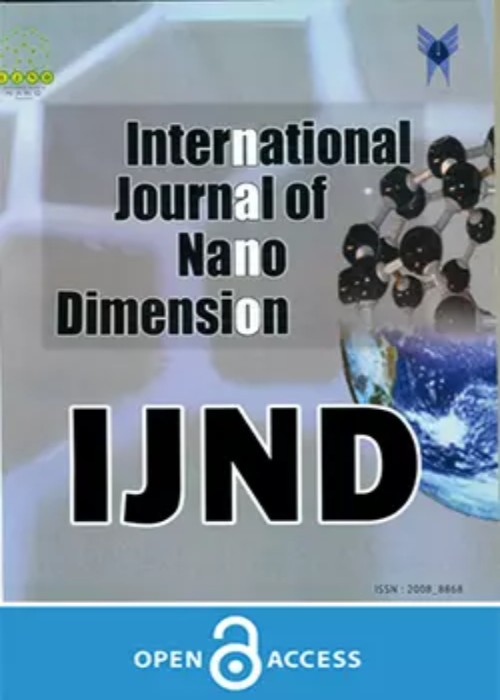فهرست مطالب

International Journal of Nano Dimension
Volume:14 Issue: 3, Summer 2023
- تاریخ انتشار: 1402/07/09
- تعداد عناوین: 8
-
-
Pages 203-211
The word "protocell" refers to lipid bilayer-coated mesoporous silica nanoparticles (LB-MSNs) which have recently come to light as a new-generation cargo transport vehicle that combines the special features of both organic and inorganic components. LB-MSN can regulate biodistribution effectively due to the presence of bilayer encapsulation while high payload capacity was due to the presence of porous nature of silica core. The MSN can be fine-tuned to generate various sizes, shapes, and surfaces while multiple cargos can be easily encapsulated with physical interaction. The bilayer coating avoids the premature release of chemotherapeutics and enhances biocompatibility. The biofunctionalization of protocells provides high colloidal stability and extends surfaces for further modification. The inorganic core can accommodate and surface-engineered multiple classes of biorelevant surface tags for active targeting. The site-specific or organ-specific delivery enhances the reliability of the material while the engineered surfaces could pave a way forward in treating various diseases. The multifaceted review highlights the potential use of bilayer encapsulated MSN for therapeutic delivery and management of multiple diseases.
Keywords: Lipid Bilayer Coating, Mesoporous silica, Protobiont, Protocell, Surface Engineering, Surface Interaction -
Pages 212-218The problem of heavy metal contamination in industrial effluents requires new and environment-friendly agents for wastewater treatment. In this study, we developed fused nanogranular polyaniline-sawdust (PANI/SD) composites for lead ion removal through the adsorption process. To prevent the aggregation of polyaniline (PANI), coconut (Cocos nucifera) sawdust (SD), an agricultural waste, was used as a substrate via in situ chemical polymerization in varied sawdust-to-aniline ratios. The scanning electron micrographs (SEM) of the obtained PANI/SD composites revealed a nanogranular structure that indicated the complete coating of polyaniline on sawdust. Furthermore, the PANI/SD composites were verified to be in the emeraldine oxidation state through Fourier-Transform Infrared (FT-IR) spectroscopy. Among the formulations studied, the PANI/SD composite with a sawdust-to-aniline ratio of 1.2 g/mL was found to have the highest adsorption capacity of 738.9 mg/g. This study presents the promising potential of PANI/SD as a novel and cost-effective adsorbent material to remove lead from contaminated water.Keywords: Adsorption, Lead, Polyaniline, sawdust, wastewater
-
Pages 219-226In this work, we reported a computational investigation on the interaction between a cycloplatinated thiosemicarbazone (CT) as antiparasitic and antitumor agents with C20 molecule. The solvent impacts were considered by the SCRF based on PCM. The relationships of solvation energies, interaction energy, dipole moment, and N-H stretching frequencies (n(NH)) values with modified-Buckingham function were illustrated. ETS-NOCV, CDA, and EDA results provided valuable understanding into the interaction between two fragments.Keywords: cycloplatinated thiosemicarbazones, C20 Molecule, Charge Decomposition Analysis (CDA), energy decomposition analysis (EDA), Extended Transition State-Natural Orbitals for Chemical Valence (ETS-NOCV), polarizable continuum model (PCM)
-
Pages 227-237This research deals with the manufacture of nickel oxide nanoparticles NiO, it has been characterized by Field emission scanning electron microscopy (FESEM), and Fourier Transform Infrared (FTIR), and their radii were range (10-20) nm and frequency (58.49%), where did not exceed the largest particles is (60 nm). Nitrogen carbon quantum dots (NCQD) were prepared based on a carbon-rich source and a nitrogen-rich source with a heat source. Nitrogen carbon quantum dots (NCQD) were prepared from L-glutamic acid as a carbon source and ethylene diamine (EDA) as a nitrogen-rich source depending on the source of heat: (reflex, autoclave, UV-digestion, oven, and microwave). The (NCQD) synthesis was characterized using spectral scanning (UV-VIS), then, the effect of its quenching ratio was studied using a sulfuric acid solution, it was found that the best thermal method is the autoclave then a UV-digester then oven and microwave. Nickel oxide-nitrogen quantum carbon dots (NiO-NCQD) are prepared from a mix between NiO nanoparticles with nitrogen carbon quantum dots as nano-adsorbent. (NiO-NCQD) has been characterized by Fourier Transform Infrared (FTIR) and energy-dispersive X-ray (EDX).Keywords: Ethylenediamine, L-Glutamic Acid, Nano-adsorbent, Nickel oxide nanoparticles, Nitrogen Carbon Quantum Dots (NCQD), Thermal Methods
-
Pages 238-256This paper proposed LC-ladder filter based on transconductance (GmC) with 130 nm RF CMOS process technology node at 1.2 V. Further, a seventh-order low-pass filter prototype and a sixth-order band-pass filter prototype have been invented to prove high-frequency functioning in a way that is relatively suited for s-parameters modelling. The low pass and band pass elements of an LC filter have been successfully implemented with GmC, and high-frequency operation has been achieved with compact passive components. To perform simulations and validate s-parameters in the intended frequency range of 2 GHz to 6 GHz, an RF-simulation platform (ADS from Keysight) has been utilised. The 8-bit capacitor-bank array used in this device allows the wideband adjustable function to be controlled by a digital or analogue signal from the external control. Due to the current mode multi-port GmC operation, an average selectivity with Q in the range of 27 to 39 has been achieved at 4.3mW, while maintaining low power consumption. By selecting the appropriate Gm and capacitive sizes for the cap-bank, it was feasible to achieve the broad operation required in the existing wireless range (2GHz-6GHz). SPICE and RF (s-parameter, harmonic balancer) simulations in ADS have been used in combination to examine the frequency response and noise performance of the proposed structure. When compared to state-of-the-art-work, the suggested Low power tunable filter stands out because to its improved frequency range, low supply voltage, better value of noise performance, and low power dissipation, which will be useful for complex analogue circuit design.Keywords: Circuit, CMOS, Filter, GmC, Inductor Emulation, Nano-Dimension, Signal processing
-
Pages 257-266The next generation of photonics and nano-optical devices may be based on two-dimensional(2D) transition metal dichalcogenides (TMDs). In this research, molybdenum diselenide (MoSe2) nanosheets, as one important member of TMDs, have been synthesized by the solvothermal method and characterized through XRD patterns, SEM, and TEM images. Nanosheets were found to have a hexagonal phase based on XRD patterns and the crystallinity percentage is 24.8 %. The lattice constants of the hexagonal phase of MoSe2 are calculated as a= 3.08 ͦ A, c= 13.72 ͦ A. The calculated average value of the crystallite size, dislocation density, and micro strain are 21.935 nm, 2.138 nm-2 and 9.070 , respectively. A few layers of nanosheets without wrinkles were observed on TEM and SEM. Next, the synthesized nanosheets were employed to prepare thin films with three different thicknesses using the spin coating method. By employing a continuous wave (CW) Nd : YAG laser at 532 nm via a Z-scan approach, this study investigates how thin film thickness affects the thermal nonlinear optical (NLO) responses of MoSe2 nanosheets. The magnitude of NLO coefficients of the prepared thin films decreased with increasing film thickness. It is observed that the prepared thin films possess saturable absorption (SA) as well as the self-focusing effect. Saturable absorbers and mode-locking devices can be developed with MoSe2 thin films because of their improved NLO properties.Keywords: [MoSe]2, Nonlinear optics, Saturable Absorption, Self-focusing, Thin Film
-
Pages 267-276Novel design methodologies of digital circuits have been caught in the spotlight of attention as a result of the dramatic increase in available data and the requirement for data processing among which Full adder cells are significant elements in arithmetic circuits design. The use of approximate computing and Multi Value Logic (MVL) can improve computational circuit efficiency. Carbon Nano Tube Field Effect Transistors (CNTFETs) with an adjustable threshold voltage is effective in the design of MVL circuits. This paper proposes a new CNTFET-based approximate quaternary full adder to reduce the area, delay, and power consumption. The Synopsys HSPICE results obtained based on 32nm Stanford CNTFET technology showed that the proposed model had much lower average power consumption, delay, power-delay product (PDP), and size as compared to other approximate full adders.Keywords: Approximate computing, Critical path delay, full adder cell, Multi Value Logic, Quaternary logic
-
Pages 277-285
The world is witnessing a transformative shift towards sustainable energy solutions, and hydrogen gas has emerged as a promising clean energy carrier with the potential to revolutionize our energy landscape. As hydrogen pipelines become an integral part of the infrastructure supporting this green energy transition, ensuring their safety and reliability becomes paramount. Among the critical challenges faced by hydrogen pipeline operators, one of the most pressing is the detection of gas leakage. Detecting hydrogen gas leaks in pipelines is not only essential for maintaining the integrity of the infrastructure but also for preventing potential safety hazards and minimizing environmental impacts. This paper presents a design to detect such leakages using two-dimensional delay line SAW based hydrogen gas sensor using COMSOL Multiphysics. The sensor is constructed with langasite piezoelectric substrate, IDT is built with aluminium and ZnO is used for sensing layer. To enhance the sensitivity of the device palladium nano particles are added to the sensor with extra conductive layer placed in the sensing layer. The proposed sensor is analysed for surface deflection, electric potential with as well as without hydrogen gas by varying the width of conductive layer from 1000μm to 3000μm.In addition to this, sensor is also tested for hydrogen environment with the concentration of gas ranging from 10ppm to 100ppm and sensitivity of the sensor is analysed. The simulated results relieved that the deflection of the sensor decreases with hydrogen gas and surface electric potential increases at all the widths of conductive layer. The conductive layer with width of 3000 μm achieved maximum deflection, electric potential and high sensitivity due to amplification provided by the conductive layer and nano particles. With hydrogen gas the sensor experiences a positive frequency shift due to change in electro acoustic effect on the sensing layer. But the sensor exhibits linearity with deflection and frequency with rise in the concentration of hydrogen gas. Further an electric equivalent model of the SAW sensor is designed using Colpitts oscillator to generate the operating frequency of SAW sensor. Electronic equivalent model is simulated using NI Multisim. The device has shown close approximation of theoretical frequency, simulated frequencies.
Keywords: COMOSL Multiphysics, Equivalent Model, Gas Leakage Detection, NI Multisim, Palladium Nanoparticles, SAW Sensors


